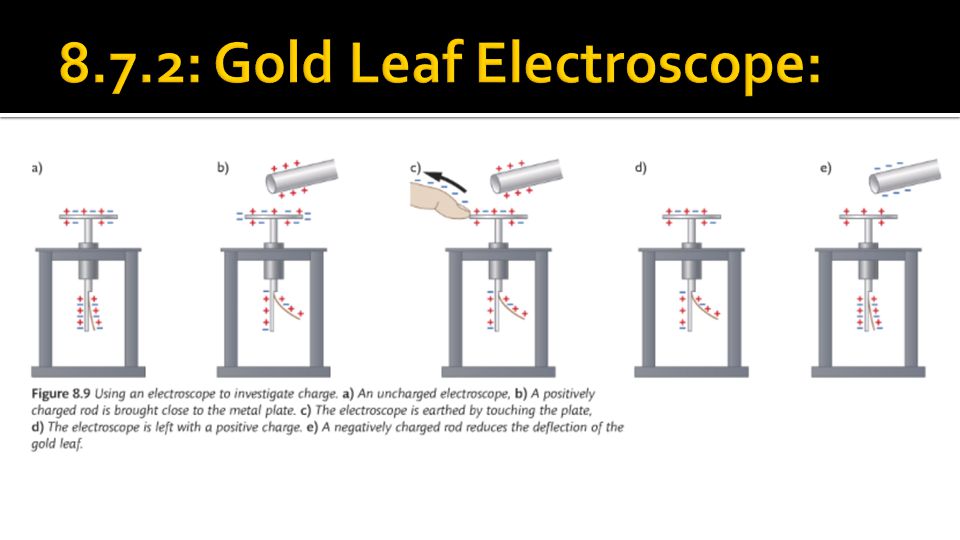ELECTROSCOPE
is the device used for detecting the presence of very weak electrical charge at rest on body
Ways of Charging Electroscope
- Charging by contact. Rub an insulator to charge it up.
- Charging by induction. This is a quick way to get a larger charge onto the electroscope
An electroscope can be charged using glass or rubber rods rubbed with silk or wool.
When the glass rod is rubbed with silk, the silk strips electrons from the rod, leaving it a positive charge.
When the hard rubber rod is rubbed with wool, it gains electrons from the wool, gaining a negative charge.
WOOL - INAONGEZA Negative Charge
SILK - INAONGEZA Positive Charge
COTTON - Positive Charge
SKIN - Negative Charge
Paper Jump - Due to the Electrostatic Force Of Attraction
When the negatively-charged rod is brought close to the electroscope, positive charges are attracted to it and negative charges are repelled away from it.
If Divergence Leaf - body is charged
Explanation Of Gold Leaf Electroscope
On bringing a negatively charged body near an uncharged "GLE". Due to Induction , Positive Charge Induced on the Cap & Negatively Charge Induced On the Leaf , The Like Charge On the Leaf. THE LIKE CHARGE ON THE LEAF REPEL EACH OTHER, HENCE THEY DIVERGE
When Cap of gold leaf electroscope touched with hand or earthed. The Free electron from leaf flow to the earth & become neutral & Leaf collapse
If You Remove Wool( negative charge ) slowly, deficiency of electron which spread through the rod , cap & the leaf. Due to the same positive charge on the leaf, it diverge.Thus , the GLE gets positively charged
To identify if body is positively or negatively charged ,
we will charge with positive charge by induction, if diverge is decrease . body is negatively charged or unchanged. If Diverge more, body is positive
An electroscope can be charged using glass or rubber rods rubbed with silk or wool. The equipment required for a set of experiments involving an electroscope: When the glass rod is rubbed with silk, the silk strips electrons from the rod, leaving it a positive charge.
POLARISATION - is process where by electron attract(moving closer) to positive charge. but not live atom
- When remove to positive charge, electron balance again
-When bring negative charge , electron run away. and when remove electron balance again
WALL AND BALOON
-Baloon is Negative which get when rubbed with hair
-Wall in neutral - means have positive and negative charge
-This make electron of the wall to be polarised - +zinakuwa karibu na - za kwenye puto
-In Polarisation does not affect the amount of charge
INDUCED CHARGE
Charge By Condution
Charging by Conduction - involve the contact of a charged object to a neutral
- If charged object is positively charged then neutral conductor will give up electrons
-If the charged object is negative, then the neutral conductor will gains electron
ELECTROPHORUS
Electrostatic induction, modification in the distribution of electric charge on one material under the influence of nearby objects that have electric charge.
An electrophorus or electrophore is a simple manual capacitive electrostatic generator used to produce electrostatic charge via the process of electrostatic induction.
Similar to the results of a NEGATIVELY, positively charged rod is brought near the knob of a neutral electroscope, it will attract some electrons up from the leaves onto the knob. That process causes both of the leaves to be positively charged (excess protons), and the leaves will diverge.
. Leaves will spread out more and more as they gain more and more charge, whether positively or negatively charged.
Deflection Of Gold Leaf badala ya ku- diverge , hutokea pale GOLD LEAF ELECTROSCOPE inapokuwa inapochajishwa kwa conduction bdala ya Induction



Comments
Post a Comment